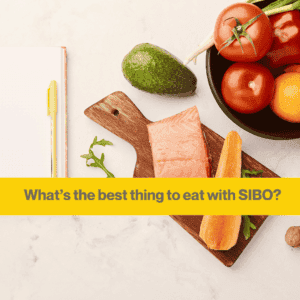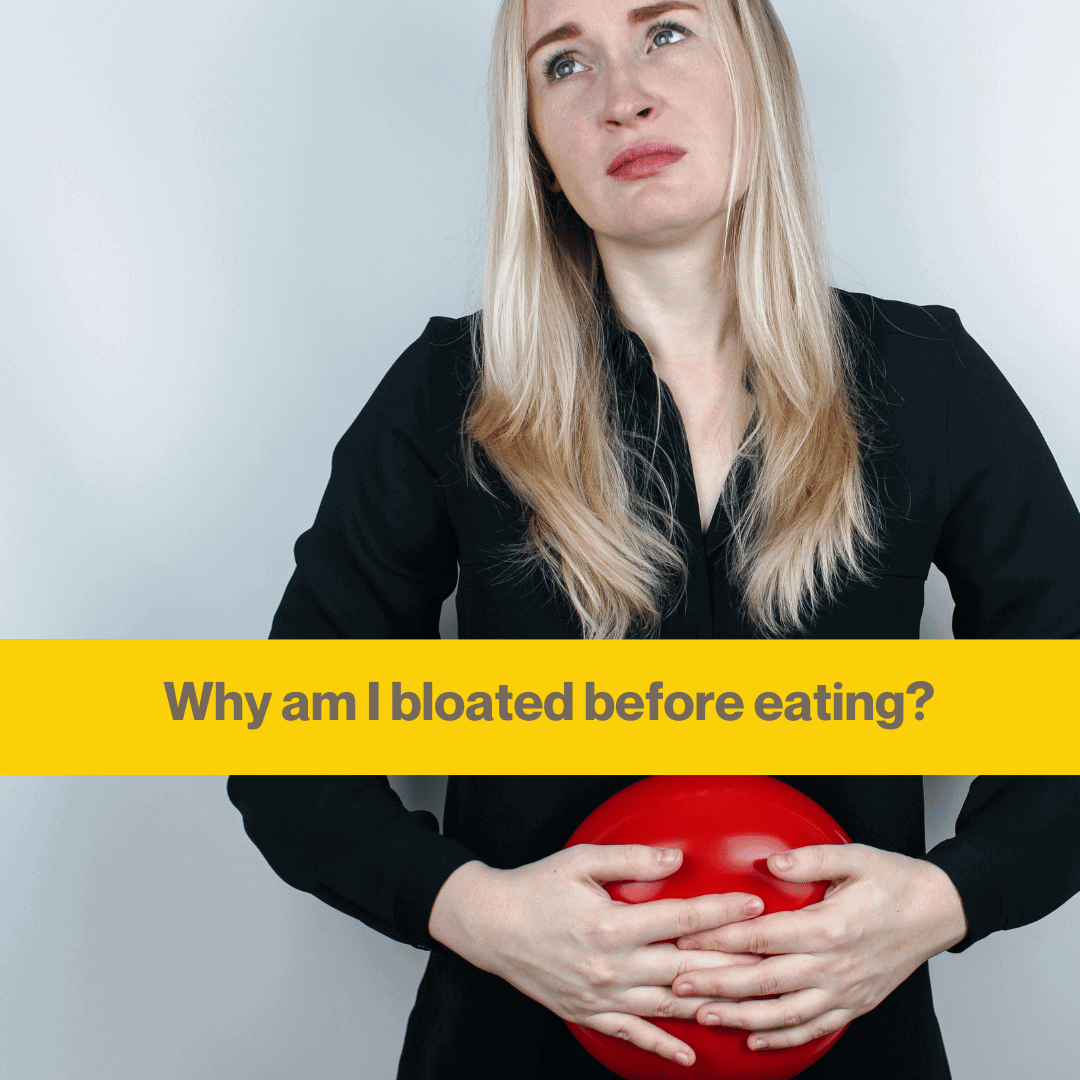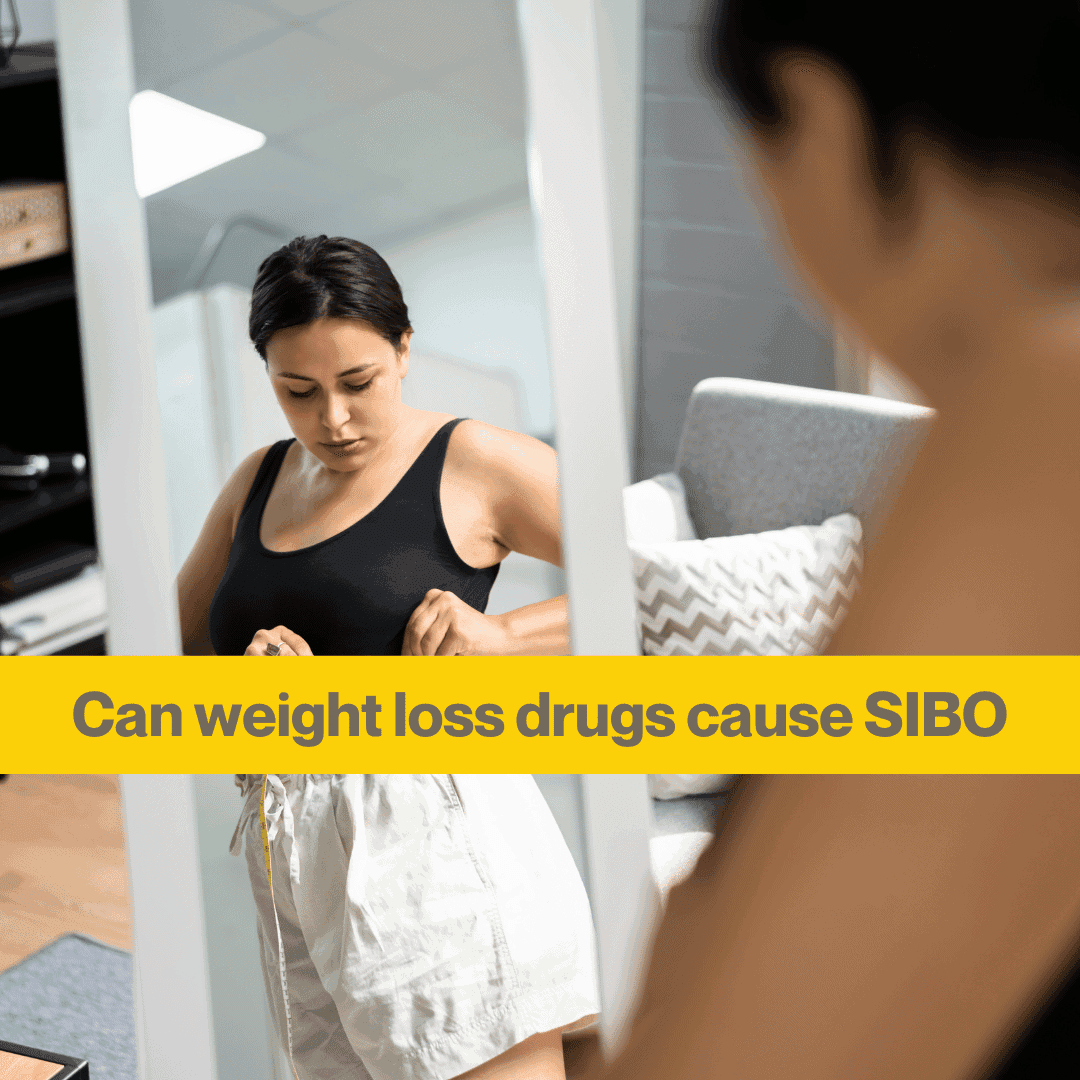What to eat when you have SIBO
If you’ve got SIBO you might be desperately searching for what to eat to help yourself feel better. In this post I want to share more about how different diets affect SIBO, and how to decide what to eat.
Understanding SIBO
SIBO occurs when there is an excessive growth of bacteria in the small intestine. This can lead to various complications, including bloating, gas, abdominal pain, and altered bowel movements.
Treatment for SIBO can take a long time (months or even years), so getting a healthy well balanced diet is important.
There are two schools of thought when it comes to what to eat during SIBO treatment. One is eat normally, or even a high fibre diet; the other position is to remove high fermentable foods.
Unfortunately, there is a lack of research data to support either position. A review of treatments for SIBO in 2022 found ‘studies are still scarce and of low quality, limiting their clinical applicability’.
From my experience working with hundreds of people who have IBS and SIBO, treating the overgrowth cannot be done by diet alone. This is backed up by research showing antibiotics or antimicrobial treatments are effective at reducing SIBO. The evidence for SIBO diets is very patchy and the studies are low quality, on the whole.
What to eat when you’re treating SIBO
There are two schools of through on whether you should include fibre in the diet or not. Diet on it’s own will not get rid of the bacterial overgrowth.
1. Starve the SIBO bacteria with diet
One suggestion is to starve out the overgrowing microbes by removing all the starches from your diet, and treat the overgrowth at the same time.
You may find your symptoms reduce as you cut down on fibre. You may feel better on a low fibre diet, but unless you retest for SIBO, you won’t know whether that’s because the microbes are there but have less to eat, or there are fewer bacteria.
2. Feed the SIBO bacteria with diet
The second (opposing) method is to continue eating fibre and other carbohydrates alongside treatment for SIBO. The theory is that the microbes are more likely to be killed as they are replicating, making the treatment more effective.
The benefit of this approach is that you are less likely to have any nutritional deficiencies because your diet will be less restricted. You may be following a SIBO treatment plan for months (or years) so overly restricting your diet may lead to problems with undereating, weight loss or low intake of calcium, B12, iron, zinc or other key nutrients.
SIBO diets – what are the options?
There are lots of different styles of low carb, low fibre diets in the online SIBO space. The best approach is to find what works for you to manage your symptoms.
The purpose of a SIBO diet is to reduce your intake of fibres that can be fermented by the gut microbes. This should help to keep your symptoms under control, but can lead to issues with food fear or nutritional deficiencies over time. You can try the low FODMAP diet – avoiding fermentable oligosaccharides, disaccharides, monosaccharides and polyols (FODMAPs), which are short-chain carbohydrates that are osmotically active and fermentable by small intestinal bacteria.
Some SIBO diets go further in their restrictive guidelines, and I’ll explain a few of them below.
Download free IBS workbook
Get my top 5 non-food IBS management strategies for better digestion
SIBO diet options
The most common SIBO diets include
- Specific Carbohydrate Diet (SCD),
- Low FODMAP Diet (LFD)
- SIBO Specific Food Guide – by Dr Siebecker
- SIBO biphasic diet by Dr Jacobi
- Elemental Diet
Specific Carbohydrate Diet (SCD)
This diet was developed for children with ongoing symptoms in coeliac disease. There is a list of ‘legal’ and ‘illegal’ foods.
The only carbohydrates allowed are monosaccharides, which allows many fruits and vegetables. The SCD excludes disaccharides and most polysaccharides, so doesn’t allow any grains, lactose, starchy vegetables. It’s use in SIBO has not been proven.
Low FODMAP diet
The Low FODMAP diet is the most common IBS dietary intervention. It was developed by the Monash University, and is well tested. The low FODMAP diet works in around 75% of cases to help reduce symptoms. In the low FODMAP diet you remove fermentable carbohydrates to reduce bloating, gas, diarrhoea and pain.
It’s thought there is a big overlap between IBS and SIBO, and many of the symptoms are the same.
SIBO Specific Food Guide – by Dr Siebecker
Dr Siebecker, regarded by many as the OG of SIBO practitioners, always recommends starting with the less restrictive diets first, before trying her controlled diet. Dr Siebecker’s diet is more controlled than the low FODMAP diet. It’s based on her clinical experience working with SIBO patients.
SIBO biphasic diet by Dr Jacobi
Dr Nirala Jacobi took Dr Siebeker’s diet and created a timed and phased approach to eating with SIBO.
The SIBO bi-phasic diet includes more restriction for 2 weeks, then expanding the diet out after.
Elemental diet for SIBO
This is a special diet made up of shakes, and no food, to be followed for 2-3 weeks. Its more of a treatment intervention than a diet to be followed. The elemental diet has all the main nutrients broken down to the smallest components so they can be easily digested.
This diet should only be prescribed by a doctor to ensure you’re getting the right level of nutrients each day. Part of the reason for that is your relationship with food, mental health and other health conditions also need to be taken into account.
Not eating solid food for three weeks is hard! There is some evidence it can reduce the overgrowth of microbes in SIBO.
Non-diet natural ways to treat SIBO
Alongside any dietary changes to manage your symptoms and treatment for SIBO, you may also want to look at ways to support your overall health. This could include interventions such as:
- Probiotics: Incorporating probiotics into your daily routine can be a game-changer. These beneficial bacteria help restore balance in the gut microbiome, combating the overgrowth of harmful bacteria associated with SIBO.
- Supplements for the gut lining – including slippery elm, psyllium, NAC or liquorice.
- Supporting nutritional deficiencies – some nutrients are more likely to be low in SIBO, including iron, B vitamins including B12, fat soluble vitamins A, D, E and K and zinc.
- Using a prokinetic to improve the migrating motor complex and motility through the small intestine. Read more about the use of prokinetics in SIBO.
If your treatment for SIBO hasn’t improved your symptoms I’ve written about eight reasons why your treatment for SIBO might not have worked.
Dietary changes to consider when you have SIBO
Creating a suitable diet is a big part of managing SIBO effectively. It can take multiple rounds of treatment to get rid of SIBO, and so you need to eat the broadest selection of foods you can during that time.
A tailored dietary approach can make a substantial impact to how quickly you recover.
Everyone with SIBO will have different triggers, so this is where working with a nutritionist trained and experienced in SIBO can really help.
I can help you with understanding what foods to avoid, and what to eat, to planning meals that support your gut health.
In summary
My overall approach would be to focus on whole, natural foods, and consider your biggest triggers from high-FODMAP foods that may exacerbate SIBO symptoms.
Opting for low-fermentation foods can minimise the production of gas in the gut, providing relief from bloating and discomfort. BUT, you don’t want to be on a restrictive diet for years and years because it can lead to reduced good bacteria in the large intestine, reduced immunity, and nutritional deficiencies.
And if you can reduce your symptoms then you’re more likely to stick with the treatment.
What to eat after SIBO treatment – your maintenance diet
Following SIBO treatment, you might be keen to start eating normally again and get back to your favourite foods. This might not always be a good idea because your digestion won’t necessarily be better after one round of treatment. (Read – 8 reasons you don’t feel better after SIBO treatment)
As your gut undergoes healing and restoration, consider the following dietary adjustments:
- Gradual Reintroduction of Foods – Slowly reintroduce high-fibre foods and complex carbohydrates into your diet post-treatment. Monitor your body’s response to different foods and gradually expand your diet to include a variety of nutrient-rich options.
- Probiotic and Prebiotic Foods – Incorporate probiotic and prebiotic-rich foods to promote a healthy balance of gut bacteria. Yoghurt, kefir, sauerkraut, and fibre-rich fruits and vegetables can support the growth of beneficial bacteria in your large intestine.
- Long-Term Maintenance – Establish sustainable dietary habits that prioritise gut health and overall well-being. Strive for a balanced diet that includes a variety of whole foods, adequate hydration, and mindful eating practices. Long term restriction of foods can lead to nutritional deficiencies.
- Regular eating pattern – Eating regularly and a normal amount of food can help with the migrating motor complex which helps to keep your small intestine cleaned.
By tailoring your diet to different phases of your healing journey, you can optimise SIBO treatment outcomes and support long-term gut health.
Do you need help with SIBO and figuring out what to do next? Whether you’ve already done a treatment round, or you’re new to SIBO, I can help.
Read about my 3 month Gut Reset here. Book a free call if you want to ask me about working with me.
Work with me - IBS Nutritionist
Book a free call to talk about working with me

IBS Nutritionist
Hi, I'm Anna Mapson, registered Nutritional Therapist.
I help people with IBS and SIBO get control of unpredictable gut symptoms to find long term relief from painful and embarrassing IBS without restrictive dieting.
I can help you to:
- understand your digestion better, so you recognise your triggers
- eat a well balanced diet, with tasty meals that are simple to prepare
- reintroduce your trigger foods so you can get back to enjoying food again
Find more about my 3 month 1:1 Gut Reset programme.
Why do I feel bloated before eating
Most people with IBS and SIBO have come to expect bloating after eating, but for some, the bloating and tightness can be worse before a meal. If you often feel uncomfortable, gassy or swollen when your stomach is empty, there are a few possible reasons worth...
Bloating and bowel changes on weight loss drugs? It could be SIBO
If you’ve started taking a weight loss injection like Wegovy or Mounjaro and your digestion has taken a turn for the worse, you’re not imagining it. These types of medication can be helpful for managing weight and blood sugar, but they may also cause excessive gas,...
How to test for SIBO in the UK
If you’ve been dealing with bloating, constipation, diarrhoea, or abdominal pain and have heard of SIBO (Small Intestinal Bacterial Overgrowth), you might be wondering how to find out if you have it. Testing for SIBO isn’t always straightforward, but there are options...








Cannot find a doctor to treat SIBO. Any suggestions?
Hi Linda, I’m not sure where you’re based but if you have a positive SIBO test already then I would take that to your GP and get a referral to a gastroenterologist. It’s worth pursuing a treatment if you know that you are positive for SIBO. If you want support with diet and lifestyle for SIBO then please do get in touch, I help my clients work out the best way to eat for their digestion.
Good morning.
Had a subtotal colectomy ; resection of terminal ileum to sigmoid colon.
Could you advice on diet etc to help with SIBO. Thankyou
Hi Veronica ,
I also had subtotal colectomy and left with ileo rectal anastomosis. I have been struggling with SIBO And leaky gut for years and I would love to connect to see what helped you and what treatment worked please.